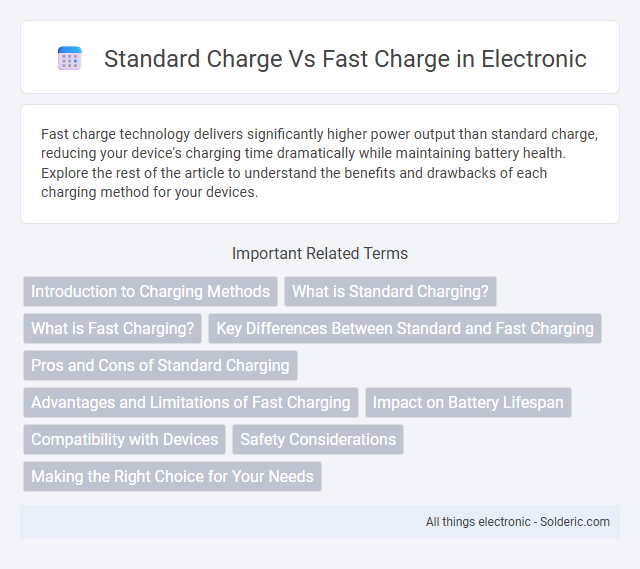Fast charge technology delivers significantly higher power output than standard charge, reducing your device's charging time dramatically while maintaining battery health. Explore the rest of the article to understand the benefits and drawbacks of each charging method for your devices.
Comparison Table
| Aspect | Standard Charge | Fast Charge |
|---|---|---|
| Charging Speed | Slow, typically 3-7 kW | Fast, typically 50 kW and above |
| Battery Impact | Low stress, extends battery life | Higher stress, may reduce battery longevity |
| Use Case | Overnight/home charging | Quick top-ups, public charging stations |
| Cost | Lower charging cost per session | Higher cost due to speed and infrastructure |
| Compatibility | Widely compatible with most EVs | Requires compatible fast charging infrastructure and vehicle support |
Introduction to Charging Methods
Standard charging delivers a steady current to replenish battery capacity over several hours, making it ideal for overnight or extended use. Fast charging employs higher voltage and current to significantly reduce charging time, often reaching 80% battery in under an hour. Both methods balance efficiency and battery health depending on usage needs and device compatibility.
What is Standard Charging?
Standard charging refers to the process of replenishing an electric vehicle's battery using a moderate power level, typically ranging from 3.3 kW to 7.4 kW, which allows for safe and efficient energy transfer over several hours. This method often utilizes Level 2 AC chargers connected to residential or public outlets, making it convenient for overnight or extended parking periods. Standard charging helps maintain battery health by reducing heat generation and stress on battery cells compared to higher power fast charging alternatives.
What is Fast Charging?
Fast charging significantly reduces the time required to recharge your device by delivering higher power levels compared to standard charging, often utilizing advanced voltage and current controls. It employs technologies such as Qualcomm Quick Charge or USB Power Delivery to safely increase charging speed without overheating the battery. You can benefit from fast charging especially when you need a quick power boost during short intervals.
Key Differences Between Standard and Fast Charging
Standard charging delivers power at a lower wattage, typically ranging from 5 to 15 watts, resulting in slower battery replenishment ideal for overnight charging. Fast charging uses higher wattage, often between 18 to 65 watts or more, enabling significantly reduced charging times by increasing current and voltage. The primary distinctions lie in charging speed, heat generation, and compatibility, where fast charging requires specific chargers and devices designed to handle elevated power safely.
Pros and Cons of Standard Charging
Standard charging offers a balanced approach with slower energy replenishment, promoting battery longevity and reducing heat generation in devices. The slower charging rate minimizes stress on battery cells, which can extend your device's overall lifespan and prevent capacity degradation over time. However, the main drawback is the longer wait time compared to fast charging, making it less convenient for users needing quick power boosts.
Advantages and Limitations of Fast Charging
Fast charging significantly reduces the time needed to recharge electric vehicles or devices, providing convenience and increased usability for users with busy schedules. However, frequent use of fast charging can accelerate battery degradation, reducing overall battery lifespan and performance over time. While it offers rapid energy replenishment, it requires specialized hardware and generates more heat, which necessitates advanced thermal management systems to ensure safety and efficiency.
Impact on Battery Lifespan
Fast charging delivers high voltage and current rapidly, which generates more heat and can accelerate battery degradation over time, potentially reducing overall lifespan. Standard charging uses a lower power rate, producing less heat and stress on the battery, helping maintain its capacity and longevity. To preserve your battery's health, favor standard charging whenever possible and reserve fast charging for urgent situations.
Compatibility with Devices
Standard charge offers broad compatibility with a wide range of devices, including older models and brands that may not support newer charging technologies. Fast charge requires specific device support and compatible chargers to achieve higher power levels, often relying on proprietary protocols like Qualcomm Quick Charge or USB Power Delivery. Ensuring your device supports fast charging is crucial for leveraging this technology without risking battery health or charging inefficiencies.
Safety Considerations
Standard charge typically operates at lower voltage and current levels, reducing risks such as overheating and battery degradation, enhancing overall safety during the charging process. Fast charge involves higher power input, necessitating advanced thermal management systems and robust battery design to prevent potential hazards like thermal runaway or short circuits. Ensuring compatibility with charger specifications and using certified equipment further mitigates safety concerns associated with both charging methods.
Making the Right Choice for Your Needs
Choosing between standard charge and fast charge depends on your device usage patterns and battery health priorities. Standard charging offers a slower, more battery-friendly process that extends battery lifespan, while fast charging delivers rapid power replenishment, ideal for users needing quick top-ups. Assessing your daily routine and valuing either charging speed or long-term battery longevity helps make the right choice for your specific needs.
Standard charge vs Fast charge Infographic

 solderic.com
solderic.com